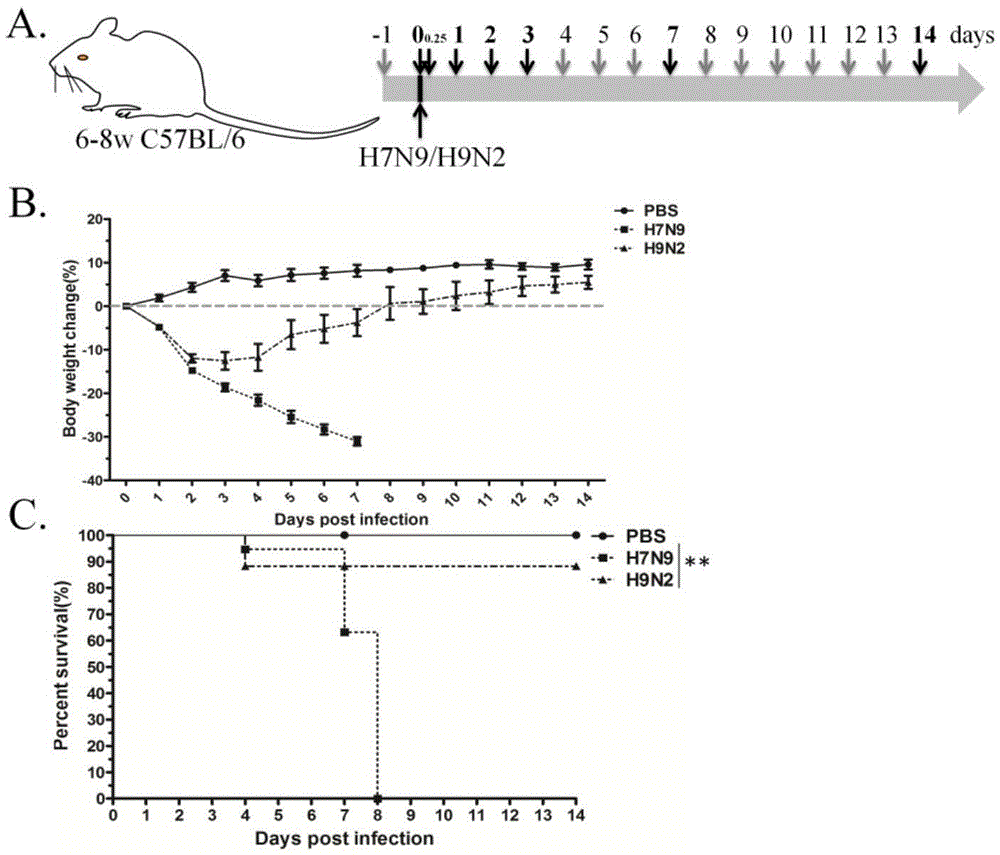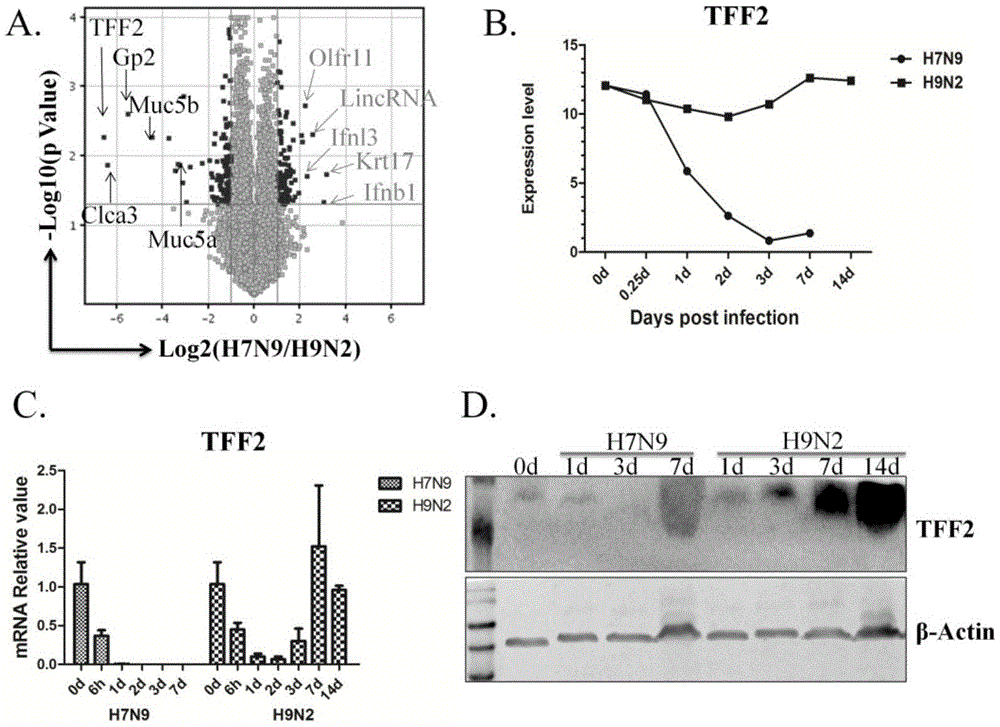Application of trefoil factor 2 in preparation of medicine for treating and preventing lung/bronchial acute inflammation diseases
A trefoil factor, acute inflammation technology, applied in the field of biomedicine, can solve the problem of unknown disease protection effect, and achieve the effect of reducing respiratory tissue damage, reducing risk and damage, and inhibiting inflammatory response
- Summary
- Abstract
- Description
- Claims
- Application Information
AI Technical Summary
Problems solved by technology
Method used
Image
Examples
Embodiment 1
[0019] Example 1: Establishment of mouse models infected with highly pathogenic influenza and low pathogenic influenza
[0020] The present embodiment adopts high dose of influenza virus H7N9 strain A / Shanghai / 4664T / 2013 (3.5*10 5 Infection amount of half tissue cells TCID50 / 50ul volume) and H9N2 virus strain A / Chicken / Shanghai / F / 98 (1.7*10 7 EID50 / 50ul (volume of half of chicken embryos) was used to infect C57 mice by intranasal drops, and 40ul / mouse was anesthetized with ketamine before infection. Put the mice into IVC cages, weigh the mice for 14 consecutive days, and observe the survival and survival status of the mice. 6 hours, 1 day, 2 days, 3 days, 7 days, and 14 days after infection, lung tissues were taken, frozen in liquid nitrogen, and used for later use ( figure 1 A). figure 1 As shown in B, the body weight of H7N9-infected mice continued to decrease. On the 7th day, most of the mice lost more than 30% of their body weight, while the H9N2-infected mice lost 12.6...
Embodiment 2
[0021] Example 2: Transcriptome chip analysis and screening of significant differential gene expression in lung tissue of mice infected with severe influenza and mild influenza, and TFF2 was screened as a protective molecule
[0022] In this example, the Agilent2100 system was used to detect the genome-wide expression profiles of the lung tissues of mice infected with H7N9 and H9N2 at the time points of 0 day, 6 hours, 1 day, 2 days, 3 days, 7 days and 14 days. like figure 2 A, We set the P value as 0.01, and screened 188 genes with significant differences, among which 85 were highly expressed in the H7N9 group, and 103 were highly expressed in the H9N2 group. The highly expressed genes in the typical H7N9 group include: Olfr11, IFN13, IFNb1, Krt17, these genes are related to inflammation; while the highly expressed differential genes in the H9N2 group include TFF2, Gp2, Muc5b, Muc5a, Clca3, these genes are related to host defense and epithelial cells Restoration is closely ...
Embodiment 3
[0023] Example three: Cloning of TFF2 gene and eukaryotic expression of TFF2 protein
[0024] This embodiment first clones the gene according to the TFF2 sequence (the nucleotide sequence of human TFF2 protein (hTFF2) is shown in SEQ ID NO: 3, the amino acid sequence is shown in SEQ ID NO: 4, and the nucleotide sequence of mouse TFF2 protein (mTFF2) is shown in SEQ ID NO : 5, the amino acid sequence is shown in SEQIDNO: 6), after transfecting the recombinant pSV1.0-TFF2 or pSV1.0-TFF2-6xHis plasmid into 293T cells, the eukaryotic expression of the TFF2 protein was detected by WB, The nickel column was eluted with different concentration gradients of imidazole, the target protein was collected, filtered and washed to obtain high-purity TFF2 protein. The specific steps are as follows:
[0025] The cDNA generated by reverse transcription of RNA extracted from the lung tissue of mice infected with H9N2 was used as a template for PCR amplification. The upstream primer was SEQ ID NO...
PUM
 Login to View More
Login to View More Abstract
Description
Claims
Application Information
 Login to View More
Login to View More - R&D
- Intellectual Property
- Life Sciences
- Materials
- Tech Scout
- Unparalleled Data Quality
- Higher Quality Content
- 60% Fewer Hallucinations
Browse by: Latest US Patents, China's latest patents, Technical Efficacy Thesaurus, Application Domain, Technology Topic, Popular Technical Reports.
© 2025 PatSnap. All rights reserved.Legal|Privacy policy|Modern Slavery Act Transparency Statement|Sitemap|About US| Contact US: help@patsnap.com



